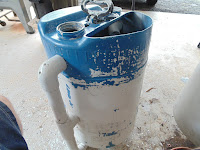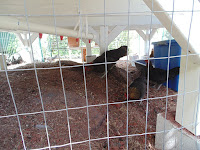Water Collection
And trying to train the girls to use it.
This is the idea. Using the natural rain water to provide for the chickens needs. The Coop is roughly 300 feet from the nearest hose bib and if you've ever tasted summer hose water, you'll know that it's not the tastiest around. JoAnn and I wanted better for the chickens. We started the system by putting up standard gutters, the PVC material allows for some easily glued up modifications.
I found and up-cycled a 20 gallon HDPE barrel. It was originally a worm tea composter. I cut off and plugged old fittings. Scraping and sanding took off the old paint. A new coat of paint and then my drilling started. I wanted to be able to see at a glance how much water was in the barrel and from the corner of the coop.
I planned on making a set up similar to the glass tube on an old fashioned coffee urn. I have a scrap section of clear 3/4" PVC pipe left over from another project that fit 3/4" CPVC fittings very nicely. I drilled then added two CPVC 90 degree elbows one above the other into the side of the barrel. TO seal the inside of the 90,
 I used slip / thread elbows and used a threaded end cap with the cap end cut off so the water would flow freely into the clear PVC. I then used a clear sealant to keep leakage down. While this was drying /setting up, I built the platform I was going to set it on out of 2 x 4 ends and a piece of plywood.
I used slip / thread elbows and used a threaded end cap with the cap end cut off so the water would flow freely into the clear PVC. I then used a clear sealant to keep leakage down. While this was drying /setting up, I built the platform I was going to set it on out of 2 x 4 ends and a piece of plywood.
You can see it in place at the far end- it has the hole cut out for the pipe and nipple assembly but without vertical support legs in this photo. I knew it would need to be stout since 20 gallons of water weighs just under 170 pounds! Two straight 2 x 4's screwed in should carry the weight.
Connecting the gutters to the tank is a simple matter of the right connectors, keeping a slope towards the tank and getting the last 90 into the tank. I filled the tank with 3 5 gallon buckets of water I lugged up from the house to see if there were any leaks, and thankfully there weren't any. I then ran the pipe with the red automatic watering nipples under the coop and secured them in place.
I have placed a bit of grain under the piping hoping that the red color will entice them to peck at it, starting the training process but as of today, I have not seen any of the 6 hens use it at all. Then again, I am not under the coop for any length of time. I will monitor the water levels and see how fast it falls, and I check every time we go out for eggs.
Update on egg production. Since getting bird 6 back, we have reliably been getting 4 and occasionally 5 eggs a day. Of course they are laid in a single nest box though there are 5 available to them. We are using cotton T-shirts for nesting material and strange as it seems, it is what they prefer. We tested with straw and cotton shirts, and even when we change the nest the shirts are in, they choose the shirts. Go figure.
Next Post: Is there a Rooster in the future?






Comments
Post a Comment